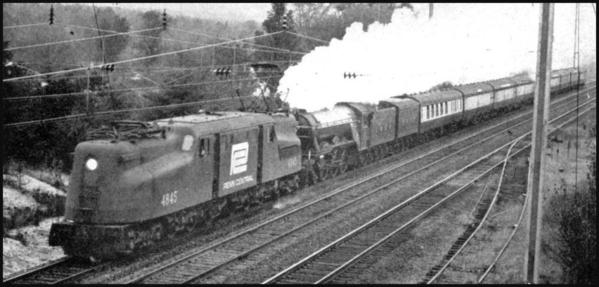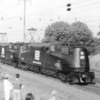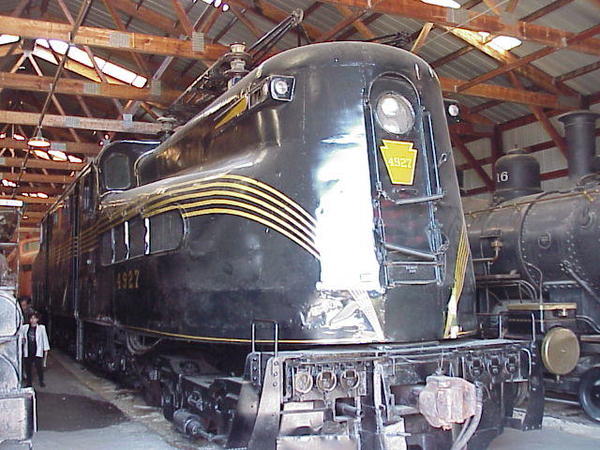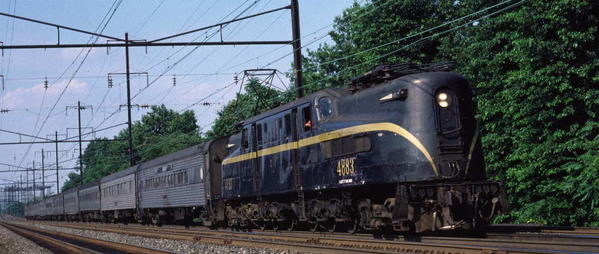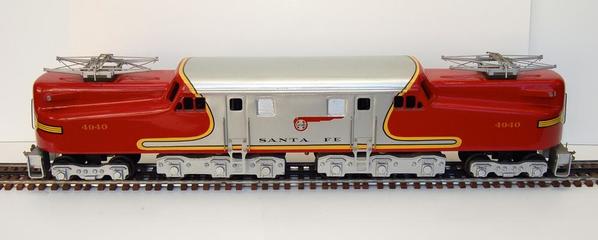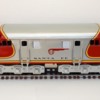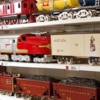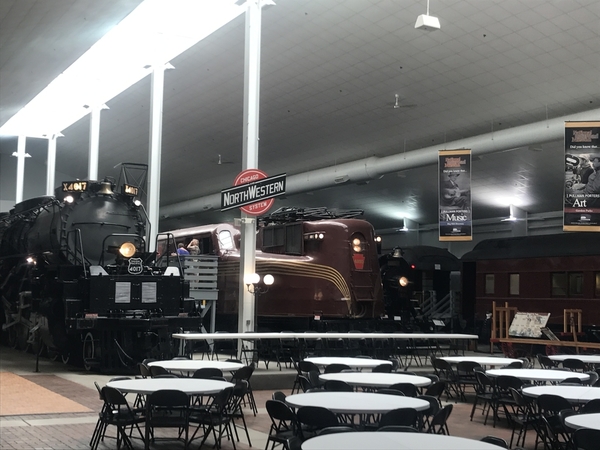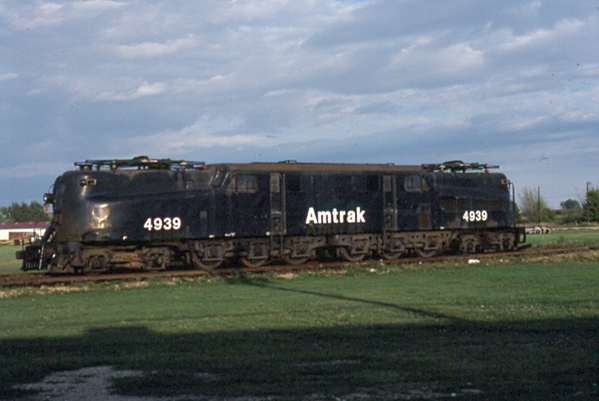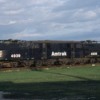Born and raised in Chicago I don't ever remember seeing them or even pictures of the here?
Replies sorted oldest to newest
Are you serious?- Jim
You don't know what you don't know. Thanks for your help.
Because they were electric and required canetery over head wiring , they are limited to areas that had such equipment. This is limited to the northeast corridor , Washington to Boston and from Philadelphia to Harrisburg . I am not sure if they were able to travel west from Harrisburg Pa . There are no bad questions ! Jim
They were at the Chicago railroad fair in 1948-1949. On the bay search chicago railroad fair and you will see pictures
I'm no Pennsy fan or expert, but I believe Summerdale Junction is correct. Harrisburg was the west end of the wire, so no GG-1's in Chicago. They may have visited, but they had to be pulled there.
Jeff,
The iconic electric GG1only ran as far west on the Pennsylvania RR as Harrisburg PA. I believe that in the days when the Pennsy was flush in capital that it considered going further west, possibly to Pittsburg, but the newer diesels changed that possibility. I'm sorry that you never had the pleasure of seeing them in operation. They were impressive indeed! They congregated in numbers at 30th St Station in Philly and I passed by there often. I took my family along for one if the "Last Runs" on the Main Line, Port Road, and Corridor years ago. A friend of mine ran them on Conrail freights into Enola yard (across the river from Harrisburg PA).
Today we just have them on videos...but with fond memories.
Earl
Jeff T posted:Born and raised in Chicago I don't ever remember seeing them or even pictures of the here?
*edited for accuracy. meant Washington not Baltimore*.... The GG1's were electric locomotives powered by 25 cycle 11,000 volt AC overhead power wire (catenary). Thus by design they were limited to railroads that had trolley wire (catenary) that had the same voltage and frequency
They were used on the PRR from New York City south to Washington DC and West to Harrisburg.
There were other overhead wire electric railroads - for example, some used DC power (the Milwaukee Road/Lackawanna/Chicago South Shore South Bend)... and some used third rail (New York Central).
There were other railroads such as the New Haven and the Virginian that used 25 cycle 11,000 volt AC electricity to power the trains. Theoretically, they could have ran the GG1 also but the PRR in it's heyday had enough work to keep the G's busy on their own trains.
Oh, and modern AC electric railroads in the USA like AMTRAK, SEPTA and New Jersey Transit use 60 cycle AC, the same frequency as used in common 220/110 house current.
Do not forget the second Great Northern electrication. It was 11000 volts, 25 cycle. I believe they had the largest electric locomotives in the US. Some of their locomotives went to the PRR after the GN discontinued electric operation, around 1956. The B and M electrification in Western Mass. I think was also 11000 volts, 25 cycle.
Many of the G's were built in Altoona so they did make a least the trip east in non-electrified territory - pulled by steam, of course. I have an old photo some place; taken in my hometown of Lewistown, PA; of a number of G's being towed east toward Harrisburg.
And with regard to David's comment about some of the Great Northern electrics going to PRR; the Pennsylvania used them as snappers in the Philadelphia area. I've read the traction motors were geared so low that the motors couldn't be operated at speeds above 30 MPH, hence their suitability in snapper service.
Curt
GG1 territory went a bit farther, south to Union Station in Washington, DC. at the time of their use, catenary ran north to Stamford, CT where the occasional GG1 would be replaced by New Haven diesel power on to Boston.
in addition, the Trenton 'cutoff' was strung with catenary and G's pulled freight on that line as well.
it wasn't until well after the G's were retired that catenary was extended up to Boston.
One of our RR group ran GG1s on his layout sans catenary. He explained that his RR liked the look of the GG1s they bought several and "dieselised" them. What a joker he was!
Larry
They were used on the PRR from New York City south to Baltimore
As Chris notes, they went to Washington. The catenary actually continued down to Potomac Yard, at the north end of Alexandria, Virginia, but only freight electrics went that far. Thewre was also catenary on the branch that ran along the east bank of the Susquehanna.
I question whether GG-1's went north of NYC. That was NYNH&H territory, and I believe they may have used different power (voltage/hertz).
The catenary didn't stop at Stamford; it went up to New Haven, until Amtrak extended it to Boston.
As pointed out in freight service GG1's ran to Potomac Yard - sometimes triple headed. From Alexandria traffic moved south via either RF&P or Southern Railway tracks. The C&O also exchanged freight with PRR in Pot yard via trackage rights over the Southern and RF&P. In the steam to diesel transition period Alexandria, VA must have been a great place to railfan.
Ed Rappe
LLKJR posted:One of uur RR group ran GG1s on his layout sans catenary. He explained that his RR liked the look of the GG1s they bought several and "dieselised" them. What a joker he was!
Larry
Not that's a Clever Little Boy!![]()
Ed, RF&P limited access to the yard, and being elevated above the adjoining streets, it was difficult to observe. I did get to go through it once, when the Four Mile Run flood control project was being planned. What I remember is all the switchers had flashing lights atop the cabs, which the boss said was so that they could keep track on their location and to make sure they weren't goofing off.
Thanks to all for the education, I certainly appreciate it!! It also helps explain why east coast modelers have such an affinity for the GG1 as well!
Summerdale Junction posted:Because they were electric and required canetery over head wiring , they are limited to areas that had such equipment. This is limited to the northeast corridor , Washington to Boston and from Philadelphia to Harrisburg . I am not sure if they were able to travel west from Harrisburg Pa . There are no bad questions ! Jim
This is correct, although the PRR did electrify a short stretch of track running from Harrisburg (Wormelysburg) to Enola. That's north for us in the real world, but railroad west (if you know what I mean). I cross those tracks every Sunday going to / from church.
With the electrification of the northeast, the Pennsy took their (now) excess K4s and L1s locomotives and moved them to other parts of the railroad, primarily Lines West.
George
Jeff T posted:Thanks to all for the education, I certainly appreciate it!! It also helps explain why east coast modelers have such an affinity for the GG1 as well!
Yes, this thread was a good education! Thanks to all who replied.
Tony
There is still catenary as far west as Lancaster/Harrisburg, PA. I'm not sure were the power change occurs on the Amtrak Pennsylvanian, though the diesels used, fit under the catenary.
BobbyD posted:LLKJR posted:One of uur RR group ran GG1s on his layout sans catenary. He explained that his RR liked the look of the GG1s they bought several and "dieselised" them. What a joker he was!
Larry
Not that's a Clever Little Boy!
Every railroad should have at least one GG1 in its roster ![]()
Gentlemen,
Although it was planned for the GG1's to run as far west as Pittsburgh, Pa it never happened, the new Diesel RR Engines got the call, they were powerful and ran cheaper. I road the Military GG1 Express, pulled by the one stripe Brunswick Green GG1, from Harrisburg to Ft Dix NJ, one of the fastest rides on earth at that time, it flew down the rails, relocating US Army Drafted Personnel, from Pa to the Training installation at Ft Dix NJ, it made no stops, and sitting inside watching, everything going past outside was a blur. Probably the fastest ride on a Train I ever took. Those GG1 Engines could really fly, especially when pulling military troup passenger cars.
Attachments
I agree. I don't have catenary wire but I run my GG1, that is what imagination is for !!
Mike CT posted:There is still catenary as far west as Lancaster/Harrisburg, PA. I'm not sure were the power change occurs on the Amtrak Pennsylvanian, though the diesels used, fit under the catenary.
The power change occurs in Philadelphia as there are not sufficient maintenance facilities in Harrisburg anymore.
I believe the G's crossed the Hellgate following the Penn Central merger.
Jon ![]()
Thanks to all who posted here... I forgot to post this, but here's some of the best GG1 video footage on the net.
GG1 cab rides in the 50's or early 60's from the Philly area all the way to Union Station in DC.
A stunning example of the PRR transportation plant. Mighty fine stuff.
RJR - In 1968 time frame my favorite place to view GG! freights headed for Pot yard was at the south end of the Potomac river bridge. Never a hassle. For North-South diesel passenger traffic the grass hillside at the Alexandria station was hard to beat.
Ed Rappe PRRT&HS 421
My favorite spot for watching GG1s was North of Trenton, where GG1s would roll through Princeton Junction at 80-100 mph. I was born too late to watch Pennsy GG1s, so I had to settle for PC GG1s. Although sometimes their top speed was 15 mph.
Since I didn't get to see the Pennsy ones, I had to settle for modeling them instead:
Attachments
KOOLJOCK1 is correct. Following the Penn Central merger, New York Penn Station to New Haven became part of the regular operating territory of the GG1.
GG1s were also operated on North Jersey Coast Line trains between New York City and South Amboy, leaving and entering the NY-Washington main line at UNION interlocking in Rahway. At the time, catenary ended at South Amboy so a locomotive change took place and operation south (railroad direction west) between there and Bay Head Junction was behind steam/diesel. The GG1s laid over at the South Amboy engine terminal between runs although, depending upon where the crew was based, some would deadhead right back to New York.
GG1's also saw service on the Amboy Secondary between MIDWAY interlocking at Monmouth Junction and South Amboy. Other than local freights, most locomotive hauled traffic over this line was coal headed to South Amboy and train frequency was sporadic so it didn't get a lot of attention. Other PRR electric types were used on the coal trains as well. In later years, heavy local freights departing west from Old Bridge would sometimes be helped to Jamesburg by a GG1 called from South Amboy. The Amboy Secondary was also used for detours resulting from major problems between MIDWAY and UNION. During the Amtrak era, a number of GG1 powered passenger trains were diverted due to accidents.
One further exception related to the operating territory of the GG1 should be noted. On October 29, 1983, NJ Transit hosted a big farewell party for its GG1s. The main celebration was held at Matawan station, and GG1 powered specials departed from there throughout the day. This was now possible as electrification had previously been extended from South Amboy. That was it for GG1 operation as NJ Transit's were the last remaining examples still in service and they were officially retired and stricken from the roster following the day's festivities.
Bob
Keystone Ed, Yes I know the spot. FYI, at that point the PRR Rosslyn Branch peeled off and went to a team yard in Rosslyn, with a siding at the Pentagon for coal deliveries. A little further south, another branch peeled off and ran on the east side of Route 1 to serve small industries---is now Crystal City. Passenger trains left the catenary north of Potomac Yard and ran on a 2-track main right along Route 1 south of what is now Crystal City.
I recall back in the sixties that the PRR ran GG1s from Baltimore to Harrisburg. I would take the train from DC's Union Station to Lewistown. The train would split in Baltimore with part going to Philadelphia and north and part going to Harrisburg and west.
Jan
Since the original question was "Born and raised in Chicago I don't ever remember seeing them or even pictures of the here?"
I am providing prove that it was in Chicago
| 4826 | 4826 | - | - | - | 4826 | 1935 | Altoona | scrapped | attended the 1949 Chicago Railroad Fair |
Attachments
Jeff T posted:Born and raised in Chicago I don't ever remember seeing them or even pictures of the here?
Well, if you were born well after 1949, then you would not have seen the GG1 that was displayed at the fantastic Chicago Railroad Fair. Note, I said "displayed", as there was no overhead 11,000 volt, 25 cycle electrification capable of powering it.
juniata guy posted:...... And with regard to David's comment about some of the Great Northern electrics going to PRR; the Pennsylvania used them as snappers in the Philadelphia area. I've read the traction motors were geared so low that the motors couldn't be operated at speeds above 30 MPH, hence their suitability in snapper service.
What are "snappers?"
I googled it and all I get is lawnmowers. lol Thanks
LLKJR posted:One of uur RR group ran GG1s on his layout sans catenary. He explained that his RR liked the look of the GG1s they bought several and "dieselised" them. What a joker he was!
I would do something like that .... GG1s are cool. I have to get one.
Pine Creek Railroad posted:Gentlemen,
...... I road the Military GG1 Express, pulled by the one stripe Brunswick Green GG1, from Harrisburg to Ft Dix NJ, one of the fastest rides on earth at that time, it flew down the rails, relocating US Army Drafted Personnel, from Pa to the Training installation at Ft Dix NJ, .....
To Ft Dix? Did they go there?
I guess you transferred to buses in Trenton?
Matt
Hot Water posted:Jeff T posted:Born and raised in Chicago I don't ever remember seeing them or even pictures of the here?
Well, if you were born well after 1949, then you would not have seen the GG1 that was displayed at the fantastic Chicago Railroad Fair. Note, I said "displayed", as there was no overhead 11,000 volt, 25 cycle electrification capable of powering it.
Born 1956, so I missed it!!
If you were posted to Ft Dix, the train only seemed to fly. ![]()
What are "snappers?"
That is what the good folks on the PRR called a "Pusher". The Brits called them "Bankers". Go figure.
Matt01 posted:juniata guy posted:...... And with regard to David's comment about some of the Great Northern electrics going to PRR; the Pennsylvania used them as snappers in the Philadelphia area. I've read the traction motors were geared so low that the motors couldn't be operated at speeds above 30 MPH, hence their suitability in snapper service.
What are "snappers?"
That is the Pennsylvania Railroad term for a helper.
Pine Creek Railroad posted:
Gentlemen,
...... I road the Military GG1 Express, pulled by the one stripe Brunswick Green GG1, from Harrisburg to Ft Dix NJ, one of the fastest rides on earth at that time, it flew down the rails, relocating US Army Drafted Personnel, from Pa to the Training installation at Ft Dix NJ, .....
To Ft Dix? Did they go there?
No, the PRR electrified main line didn't go through Fort Dix, New Jersey. I served my Basic Training at Fort Dix, in late 1964.
I guess you transferred to buses in Trenton?
Probably.
Matt
I saw one in person in Dallas Texas, but it was in the Train Museum at the Cotton Bowl Fairgrounds. I never saw it operate, but it was very large. They also had some Union Pacific Diesel engine that was as large or larger than the GG-1. A very impressive collection of trains/engines in such a small space.
aussteve posted:I saw one in person in Dallas Texas, but it was in the Train Museum at the Cotton Bowl Fairgrounds. I never saw it operate, but it was very large. They also had some Union Pacific Diesel engine that was as large or larger than the GG-1. A very impressive collection of trains/engines in such a small space.
That museum has since been relocated to a different location away from Dallas, to Frisco, Texas.
OK, time for a Pennsy vocabulary lesson:
Snapper - helper engine
Shifter - switcher engine
Cabin Car - what the unwashed call a "caboose" ![]()
George
Thru troop movements HBG to Ft Dix probably did not operate into 30th St. Might have changed engines at Frankford Jct. ?
Attachments
Gentlemen,
Actually not inside Trenton, the stop was set up outside all on it's own, and run by the US Army, OD Green busses, cold & damp as all get out, during the winter months. I reported in January.
PCRR/Dave
terry hudon posted:
Those look great - nice job! ![]()
I will admit to messing around with a photo of the Williams Conrail GG-1 and trying for a Great Northern blue & white and mountain goat logo. I recall seeing one in GN orange & green. Is that yours too?
It also would have been interesting seeing a GG-1 making it out west under Milwaukee wire somewhere.
I always thought an interesting, "what if" concept would have been the Milwaukee Road's Pacific Extension where they never de-electrified the RR like they did in '72. And when the GG-1s stopped running back east, a large "hospital train" brought them to Tacoma where they were repainted and replaced the aging bi-polars...
Imagine two GG-1s in this scene, painted the same as these units:

Wasn't the Milwaukee Road overhead all DC?
Anything is possible when you dream![]()
Those Milwaukee units weren't small potatoes either. What HP did they have ??
I don't know... that SP rig looks pretty sweet... ![]()
I saw GG1's every day in the mid 50's and beyond. When I was working In downtown Philly I rode behind the G's many times.
In 1976 4800 in the Bicentennial scheme was parked at 30th street station for everybody to see. It was incredible to see.
They were incredibly quiet when running also, I know many a picture was missed waiting for one to come by and when it did the G came by so fast and so quiet you barely had time to get a picture if you did get one.
Attachments
Hot Water posted:Wasn't the Milwaukee Road overhead all DC?
Yes. The Milwaukee Road electrification was constructed to operate at 3,000 volts direct current. An upgrade to 3,400 volts was implemented following acquisition of the EP-4 and EF-4 "Little Joes" in order to maximize their performance. The Russian system the for which the locomotives were built was 3,300 volt DC and, following initial operations, the railroad determined the increase in voltage would make better use of their available power.
Bob
CNJ 3676 posted:Hot Water posted:Wasn't the Milwaukee Road overhead all DC?
Yes. The Milwaukee Road electrification was constructed to operate at 3,000 volts direct current. An upgrade to 3,400 volts was implemented following acquisition of the EP-4 and EF-4 "Little Joes" in order to maximize their performance. The Russian system the for which the locomotives were built was 3,300 volt DC and, following initial operations, the railroad determined the increase in voltage would make better use of their available power.
Bob
One has to wonder if AC powered electrics became available at the right price if the Milwaukee Road would have upgraded to common 60 hertz 11kV AC power.
Somewhere on here is a link to a pretty good dissertation about the Milwaukee and mergers which talked about the shortcomings of the electrification in the 60's and 70's as well as the managerial and economic reasons that led to its demise (in the author's opinion). I have it saved, it's good stuff.
*** armchair speculation following ***
On a different note, the truck sideframes/castings on the GG1 and the Little Joes look similar for both sets of trucks - close to the NH EP1 (or whatever they were named) and the CUT P motors. I believe the G's were all "thirties tech" quill drive motors and the Joes were fourties/fifties tech DC traction motors a la 752. *Disclaimer - my technical knowledge, like most everyone else, is based upon what I read, so this is pure speculation. ***
Thus I suspect that a conversion of G's to run on the Milwaukee would have been prohibitively expensive...
CNJ 3676 posted:Hot Water posted:Wasn't the Milwaukee Road overhead all DC?
Yes. The Milwaukee Road electrification was constructed to operate at 3,000 volts direct current. An upgrade to 3,400 volts was implemented following acquisition of the EP-4 and EF-4 "Little Joes" in order to maximize their performance. The Russian system the for which the locomotives were built was 3,300 volt DC and, following initial operations, the railroad determined the increase in voltage would make better use of their available power.
Bob
Of course, I was pipe-dreaming on the paint schemes, but that's interesting. I remember an article somewhere about the Milwaukee substation operations with their motor-generator units and the DC (dynamic brakes I think) being fed back into the system from the downhill-running locomotives. Apparently there could be some scary lightning shows at certain times and the operators stayed off the machinery floor. Any expert knowledge on this?
No worries on the north-east racetracks I would guess. Were there any serious grade-climbing for the GG-1s?
This former Jersey boy must point out with pride that the furthest east a GG1 ever ran was to Matawan, NJ on the North Jersey Coast line. In fact the final run of the GG1 (October, 1983) departed from Matawan.
Steven J. Serenska
The Matawan exception of 10/29/83 was already noted in my post of the 21st on page 1 of the thread.
David1,
I never got to see the Real Bicentennial 4800 GG1 Engine, man I bet she was really something, do you have any pictures of the real engine. If you do please post them for us to see!
PCRR/Dave
I have some books on inter urbans and electrification and, I guess, there was no "perfect" electric current to use. Everything was a compromise plus GE and Westinghouse were promoting competing systems. When I looked in to the GG1 at the Pa. RR Museum I was amazed at how full of equipment it was and how little space the engineer had.
CNJ 3676 posted:The Matawan exception of 10/29/83 was already noted in my post of the 21st on page 1 of the thread.
Here is a copy of the brochure from that "Matawan exception of 10/29/83". I didn't get to ride on it, but I was there when it returned to Matawan. I'll have to look around... I think I have some picture I took that day. The brochure was tri-fold, so the picture was the cover, but the text starts on the second page of the attachment.
Attachments
I've got that same brochure. I was there for a good part of the day although I didn't take a ride. I was commuting into the city at the time and rode train 3323 home the evening before on the 28th. Powered by the 4879, it was the last regularly scheduled train to depart New York Penn Station behind a GG1. The 4877, 4879 and 4882 were the three GG1s used for the farewell festivities on the 29th.
Here's one of my shots of the 4877 after it was repainted into PRR Tuscan livery. It is westbound at Elizabeth on July 11, 1981.
Bob
Attachments
Pine Creek Railroad posted:David1,
I never got to see the Real Bicentennial 4800 GG1 Engine, man I bet she was really something, do you have any pictures of the real engine. If you do please post them for us to see!
PCRR/Dave
Taken by one of my railfan aquaintances, Kermit Geary, here's a shot of the 4800 when it was assigned to the Baltimore tunnel helper job. The trailing Gs were the train power.
Bob
Attachments
I have no pictures when 4800 was at 30th street but one story from the Amtrak personal on site was that they were thinking of painting 3 or 4 passenger cars into the Bicentennial scheme.
Although the GG1 was incredible the passenger cars would have been too gaudy for my taste. It seems Amtrak came to its senses before going ahead with the passenger cars.
Being an "Electric's Nut", you would probably think that I would have known the different supply circuits AC vs DC that powered the different motors that were America Built, but until I read all of this post, I didn't have the slightest idea!
Now here is the question, I wonder which was the best/less expensive to make and install AC or DC?
Seems like that would have driven the Supply Standard!
Probably no different that GE and EMD, as they have their own differences.
Great Post, and thanks to everybody for the comments, as it improved my knowledge on the "Railroad Motors".....................Brandy!
jim pastorius posted:I have some books on inter urbans and electrification and, I guess, there was no "perfect" electric current to use. Everything was a compromise plus GE and Westinghouse were promoting competing systems. When I looked in to the GG1 at the Pa. RR Museum I was amazed at how full of equipment it was and how little space the engineer had.
Yes. The GG1's cab was very cramped. Whenever an extra man rode in the forward cab, you had to stand directly behind either the Engineer or Fireman in the space leading to the door. I conked my head on more than one occasion on that bulkhead extending down from the ceiling which bisected the cab.
Bob
Jeff T posted:Born and raised in Chicago I don't ever remember seeing them or even pictures of the here?
Jeff - Can you please correct the title of this thread to "Were", not "Where"?
Attachments
Since we moved back in August I haven't located it but do remember seeing it here I have framed a book on GG1's mainly the first one it was the story of it read it once then framed it need to dig it out again. It was produce by some model railroad club in PA around Lancaster I can't remember which one but I do know the book is out of print. found it titled " Career of a Champion" The Story of the first GG1 by Frederic H. Abendschien and Dan Cupper. Found a copy on amazon if anyone is interested http://www.amazon.com/Career-c...-first/dp/B0006EJJB6
1984 Lancaster chapter, NRHS
342 W.Fritz Avenue
Quarryville, PA 17566
When I learned that the MILW electrification was 3000 VDC, I used to daydream about riding a Lackawanna MU across Montana! ...or a "Little Joe" hauling hoppers of stone on the Gladstone (NJ) Branch.
"The EP-5s were rapidly replaced on Washington–Boston trains by the reliable former PRR GG1 electrics." This statement from Wikipedia indicates that GG1 locomotives did operate on the New Haven Railroad.
CNJ 3676 posted:jim pastorius posted:I have some books on inter urbans and electrification and, I guess, there was no "perfect" electric current to use. Everything was a compromise plus GE and Westinghouse were promoting competing systems. When I looked in to the GG1 at the Pa. RR Museum I was amazed at how full of equipment it was and how little space the engineer had.
Yes. The GG1's cab was very cramped. Whenever an extra man rode in the forward cab, you had to stand directly behind either the Engineer or Fireman in the space leading to the door. I conked my head on more than one occasion on that bulkhead extending down from the ceiling which bisected the cab.
Bob
Hey Bob... What did the crews think of the GG1s?? Were they cold in the winter? hot in summer ,reliable? .Did wet weather come into play?
Visibility isn't that great compared to modern diesels... I suppose with all that electricity around crews had to be specially trained. speed restrictions? just curious.
Hi, Gregg.
There was a great deal of respect for the GG1s among the employees. The guys I knew regarded it as a privilege to have an opportunity to work with them. Once we reached the mid-70s, the oldest ones had logged 40 years of dependability in high profile service. As I was attending school in western New York state, I served an internship on Conrail's Central Region. The employees knew I was from New Jersey and even they asked me questions about the GG1s since they knew I had grown up around them. The locomotives had clearly earned themselves legendary status, not just among enthusiasts but professional railroaders as well.
That said, it's interesting to examine some of the qualities of the GG1 which you asked about. The cabs were quite primitive and had a very 1930s feel to them which makes sense since that's when they started building the locomotives. The cabs were very cold in the winter and hot in the summer. To combat the summer heat, you'd keep the windows open but then you'd have to contend with the lound sound of the breaking wind as the train moved along at high speed. In the winter, you'd just have to bundle up. I have pictures in which Enginemen are wearing ski caps. Regarding the visibility aspect, as can be seen in pictures taken facing forward along the front of the car body, visibility from the cab certainly wasn't an attribute but having a man on each side worked fine.
Operation of the GG1s was quite interesting. The controller (throttle) had a passenger setting and a freight setting. There were 22 notches for passenger and 17 for freight service. Reviewing employee timetables for PRR, Penn Central, Amtrak, Conrail and NJ Transit, the highest maximum authorized speed I can find for the GG1 at any one time was 100 miles per hour but I, along with most everyone else who was familiar with them, can attest to the fact they were capable of and did run at higher speeds. Based upon his own experiences, one Fireman recounted stories in which a pair of Gs in multiple could maintain 90 MPH with about 70 loaded TOFC flats and 70 MPH with 125 car manifest freights. As has been previously published, a large number of the locomotives were re-geared for 90 MPH. These were the locomotives which were used in freight service but were also still perfectly capable of passenger service. In fact , the thirteen GG1s conveyed to the New Jersey Department of Transportation for North Jersey Coast Line trains between New York City and South Amboy, the 4872-4884, were part of the re-geared group. Interestingly enough, a weakness of the GG1 was starting heavy tonnage. They could be rather slippery when starting heavy freight trains and it required the combined tractive effort of multiple Gs to get heavy trains started and up to track speed but once they got rolling, they rolled. Their acceleration in passenger service was incredible. Coming off the Perth Amboy & Woodbridge Branch with a NY&LB train onto the Northeast Corridor at UNION, once the last car cleared the interlocking, the Engineer would notch out the throttle and the locomotive took off like it was shot out of a cannon. The acceleration was that impressive.
As the 70s progressed, the age of the GG1s really began to show. There had been deferred maintenance during the final years of the Pennsy and throughout Penn Central and despite the best effort of the Wilmington shop workers, reliability began to suffer. Conrail retired its fleet and Amtrak's locomotives soldiered on into the early 80s. Amtrak's GG1s were seen running in multiple more frequently in order to protect schedules. Once Amtrak's fleet was removed from service, the thirteen NJDOT/NJ Transit examples were the last remaining GG1s in regular service. By the time they were retired in October 1983 and replaced by consists of Comet cars powered by ex-Amtrak HEP equipped E60CHs on through trains to New York , their time had come. No premature retirement in this case...these were locomotives which were literally worn out.
Bob
Thank you so much Bob...... . Really good post & info.
My pleasure.![]()
I was just going through some of my slides and found the attached picture which ties into the story I told about eastbound NY&LB trains accelerating away from UNION. For this shot, I was standing on the platform at North Rahway just east of Rahway station. The Engineer has opened the throttle and the 4872 is digging in for the high speed dash through Linden into Elizabeth before slowing for the speed restriction through the famous "S" curve. If you look closely in front of the first driver you'll notice the Engineer is putting down sand to help his G gain speed. The sound of the GG1s as they rapidly accelerated was not easily forgotten. It was best heard from the first car, preferably if the car was positioned with the vestibule in front so you could stand immediately behind the locomotive...they used to let you do things like that back in the day once they got to know you. Heck, the G's have been gone for more than thirty years now but I can still hear their signature sounds like it was yesterday. "Next stop Newark Penn Station!" As much as I enjoyed my time aboard them and riding trains pulled by them, the GG1s were just as thrilling when viewed trackside.
Bob
Attachments
Thanks for the GG1 stories !! Have always loved them although never I never saw one running. The several trips I took east to NYC by train I might have been pulled by one. I was so thrilled when I found one at a bargain price and it has always ran well.
Gpritch posted:Jeff T posted:Born and raised in Chicago I don't ever remember seeing them or even pictures of the here?
Jeff - Can you please correct the title of this thread to "Were", not "Where"?
A Very Good Suggestion PLEASE Consider it
Doug
Thank you to all who posted their own photos of the GG1. Its good to see these "new" photos. Keep them coming
Here's the 4883 westbound approaching North Elizabeth station. It along with the 4880 retained the PRR DGLE single stripe livery, minus PRR Keystone heralds of course, right up until withdrawal of the NJT fleet in 1983. This picture was taken 7/9/82, the last full calendar year of GG1 operation.
I was commuting into the city at the time and, if the evening weather forecast was favorable, I'd take my camera to work and ride a local to one of the Northeast Corridor stations to do some shooting before heading home for the night. That typically entailed catching a South Amboy local and changing to a Bay Head bound train there. There were others doing this as well and, all having come straight from the office, I'm sure we made for an entertaining sight in our jackets and ties hanging out taking train pictures.
Bob
Attachments
If a troop train was running direct from Harrisburg to Ft Dix, the engine change was probably made at Frankford Jct.
How about a GG-1 painted in the Santa Fe Warbonnet scheme? This one is Standard Gauge and custom painted.
Looks really nice in the warbonnet paint. Sure, it's a fantasy piece, but that doesn't stop it from looking great!
ARNO
Attachments
CNJ 3676 posted:KOOLJOCK1 is correct. Following the Penn Central merger, New York Penn Station to New Haven became part of the regular operating territory of the GG1.
GG1s were also operated on North Jersey Coast Line trains between New York City and South Amboy, leaving and entering the NY-Washington main line at UNION interlocking in Rahway. At the time, catenary ended at South Amboy so a locomotive change took place and operation south (railroad direction west) between there and Bay Head Junction was behind steam/diesel. The GG1s laid over at the South Amboy engine terminal between runs although, depending upon where the crew was based, some would deadhead right back to New York.
GG1's also saw service on the Amboy Secondary between MIDWAY interlocking at Monmouth Junction and South Amboy. Other than local freights, most locomotive hauled traffic over this line was coal headed to South Amboy and train frequency was sporadic so it didn't get a lot of attention. Other PRR electric types were used on the coal trains as well. In later years, heavy local freights departing west from Old Bridge would sometimes be helped to Jamesburg by a GG1 called from South Amboy. The Amboy Secondary was also used for detours resulting from major problems between MIDWAY and UNION. During the Amtrak era, a number of GG1 powered passenger trains were diverted due to accidents.
One further exception related to the operating territory of the GG1 should be noted. On October 29, 1983, NJ Transit hosted a big farewell party for its GG1s. The main celebration was held at Matawan station, and GG1 powered specials departed from there throughout the day. This was now possible as electrification had previously been extended from South Amboy. That was it for GG1 operation as NJ Transit's were the last remaining examples still in service and they were officially retired and stricken from the roster following the day's festivities.
Bob
Bob,
I was a conductor out of Penn from 1974 to 1987. Worked passenger to DC and down the Jersey Coast in addition to drilling cars in Penn Station and Sunnyside Yard.
Ponz
My only "fantasy" GG-1 would have been a silver one (similar to the ones painted for the Congressional) but with a purple stripe for ACL's Champion. After all they did haul the C to and from NYC and DC.
As a kid, growing up in Northeast Philly and visiting family in maple Shade, New Jersey, we would always take the Tacony-Palmyra bridge. Many times a GG1 pulling a passenger train passed over us as we went under the PRR bridge before entering the Tacony-Palmyra approach. It wasn't until 1978 that I took my trusty SLR camera down to the tracks just south of the T P bridge and photographed GG1s pulling passenger and freight trains. I can still feel the excitement as I stood maybe ten feet away from the tracks and a PC painted G roared by. The ground seemed to shake as my adrenaline spiked. What a thrilling experience.
Here are two pictures I took that year. Both were slides that I transferred to the computer. The slides had been in storage in my attic and their quality deteriorated a bit. First is 4935. Second is a GG1 in PC livery.
Attachments
GG1's ran on New Haven track prior to the Penn Central Merger. Recall the wreck of the Congressional in 1953. The GG1 picked up the train in New Haven for the run to DC.
Stuart
Big Jim posted:What are "snappers?"
That is what the good folks on the PRR called a "Pusher". The Brits called them "Bankers". Go figure.
The Brits call them "Bankers" because they assist trains in climbing emBANKments. That's what they call grades over there. That and "inclines" as in the Lickey Incline, the steepest mainline grade in England at "1 in 37.7' or 2.65%.
Stuart posted:GG1's ran on New Haven track prior to the Penn Central Merger. Recall the wreck of the Congressional in 1953. The GG1 picked up the train in New Haven for the run to DC.
Stuart
Never in regular service.
A New Haven electric handled the train from New Haven to Penn Station, where GG1 4876 took over. The number of the NH unit is lost to history but it would have been one of the road's EP-4 streamliners or possibly one of the similar looking EF-3b units which were built as freight motors but later received steam generators for passenger work on trains to and from Penn Station.
The EP-4 had third rail gear and could operate on either 11000 volt catenary or 600 volt DC third rail. The EF-3b was an AC only machine.
FYI: It was the overnight Federal Express from Boston that wrecked in DC, not the Congressional.
Nick Chillianis posted:Stuart posted:GG1's ran on New Haven track prior to the Penn Central Merger. Recall the wreck of the Congressional in 1953. The GG1 picked up the train in New Haven for the run to DC.
Stuart
Never in regular service.
A New Haven electric handled the train from New Haven to Penn Station, where GG1 4876 took over. The number of the NH unit is lost to history but it would have been one of the road's EP-4 streamliners or possibly one of the similar looking EF-3b units which were built as freight motors but later received steam generators for passenger work on trains to and from Penn Station.
The EP-4 had third rail gear and could operate on either 11000 volt catenary or 600 volt DC third rail. The EF-3b was an AC only machine.
FYI: It was the overnight Federal Express from Boston that wrecked in DC, not the Congressional.
Dat's Right! ![]() When it Positively HAS TO be there!
When it Positively HAS TO be there!![]()

They went out west as far as Altoona for major repair(towed there) and ware 124 GG1s were made and Enola for maintenance and transfer freight cars, They went as far south as Alexandria Potomac yard to transfer freight cars.
Enola
Alexandrea Potomac yard.

prrhorseshoecurve posted:Nick Chillianis posted:Stuart posted:GG1's ran on New Haven track prior to the Penn Central Merger. Recall the wreck of the Congressional in 1953. The GG1 picked up the train in New Haven for the run to DC.
Stuart
Never in regular service.
A New Haven electric handled the train from New Haven to Penn Station, where GG1 4876 took over. The number of the NH unit is lost to history but it would have been one of the road's EP-4 streamliners or possibly one of the similar looking EF-3b units which were built as freight motors but later received steam generators for passenger work on trains to and from Penn Station.
The EP-4 had third rail gear and could operate on either 11000 volt catenary or 600 volt DC third rail. The EF-3b was an AC only machine.
FYI: It was the overnight Federal Express from Boston that wrecked in DC, not the Congressional.
Dat's Right!
When it Positively HAS TO be there!
I've seen that photo or a similar one in, the past. I hadn't noticed that the rear motor truck was damaged.
I seem to remember taking a passenger train from New London, CT to Philly and they had a GG1 with another engine in front that they unhooked when we got to NYC. I was in the Navy Sub School there in 1975.
During the late '60-early '70s I rode behind GG1s from Phila to NYC often on bussiness, and on occasion, to New Haven, CT. (which was the end of the electric service back then). Unfortunately, they were painted Penn Central dull black.
moderneraSG posted:
To me, these graphics make it look like it didn't know if it was coming or going. The PRR single stripes did not have that problem.
The GG1 is such an iconic locomotive that one or two should be towed to West Coast museums and given Pennsy 5-Stripe paint jobs.
Bobby Ogage posted:The GG1 is such an iconic locomotive that one or two should be towed to West Coast museums and given Pennsy 5-Stripe paint jobs.
I can't imagine ANY "West Coast museum" wanting a GG1, what with the restoration and up-keep expense.
jhz563 posted:
There is one in Frisco, TX, just north of Dallas. That is the furthest west where one can be found. That GG1, 4903, went to Dallas from Elkhart, IN, in exchange for NYC L-3a Mohawk 3005
Nick Chillianis posted:jhz563 posted:There is one in Frisco, TX, just north of Dallas. That is the furthest west where one can be found. That GG1, 4903, went to Dallas from Elkhart, IN, in exchange for NYC L-3a Mohawk 3005
Illinois Railway Museum also has one, since restored to the Pennsy 5-stripe paint scheme:
It's been long time now since these things were taken out of service and donated. There aren't any more available from Amtrak or NJT, even if a "west coast museum" wanted one..
Rusty






